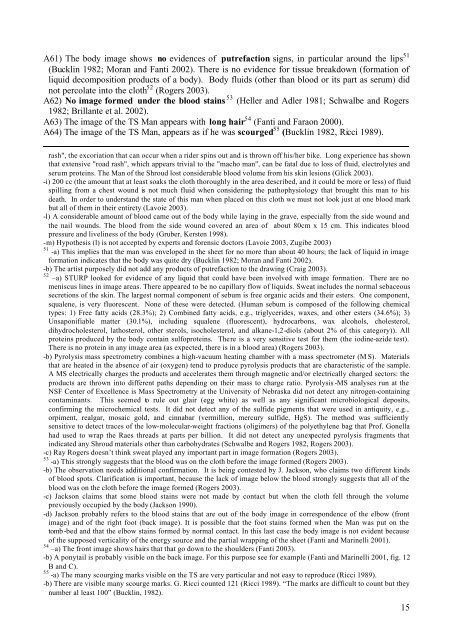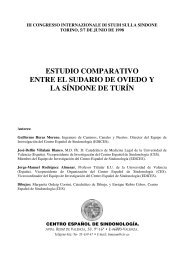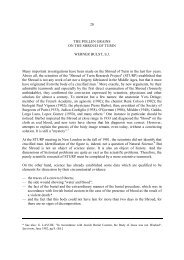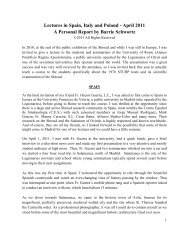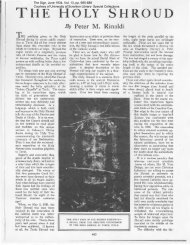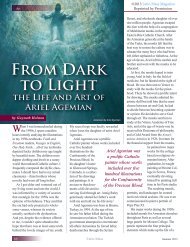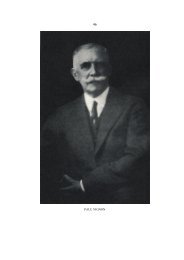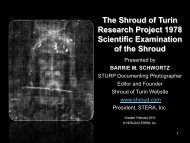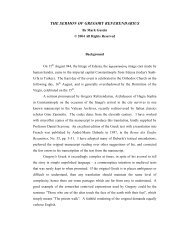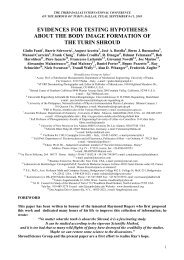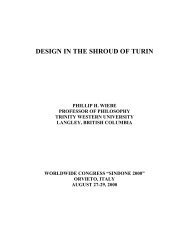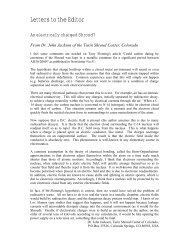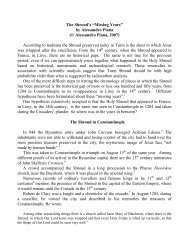list of evidences 10d Barrie - The Shroud of Turin Website
list of evidences 10d Barrie - The Shroud of Turin Website
list of evidences 10d Barrie - The Shroud of Turin Website
Create successful ePaper yourself
Turn your PDF publications into a flip-book with our unique Google optimized e-Paper software.
A61) <strong>The</strong> body image shows no <strong>evidences</strong> <strong>of</strong> putrefaction signs, in particular around the lips 51(Bucklin 1982; Moran and Fanti 2002). <strong>The</strong>re is no evidence for tissue breakdown (formation <strong>of</strong>liquid decomposition products <strong>of</strong> a body). Body fluids (other than blood or its part as serum) didnot percolate into the cloth 52 (Rogers 2003).A62) No image formed under the blood stains 53 (Heller and Adler 1981; Schwalbe and Rogers1982; Brillante et al. 2002).A63) <strong>The</strong> image <strong>of</strong> the TS Man appears with long hair 54 (Fanti and Faraon 2000).A64) <strong>The</strong> image <strong>of</strong> the TS Man, appears as if he was scourged 55 (Bucklin 1982, Ricci 1989).rash", the excoriation that can occur when a rider spins out and is thrown <strong>of</strong>f his/her bike. Long experience has shownthat extensive "road rash", which appears trivial to the "macho man", can be fatal due to loss <strong>of</strong> fluid, electrolytes andserum proteins. <strong>The</strong> Man <strong>of</strong> the <strong>Shroud</strong> lost considerable blood volume from his skin lesions (Glick 2003).-i) 200 cc (the amount that at least soaks the cloth thoroughly in the area described, and it could be more or less) <strong>of</strong> fluidspilling from a chest wound is not much fluid when considering the pathophysiology that brought this man to hisdeath. In order to understand the state <strong>of</strong> this man when placed on this cloth we must not look just at one blood markbut all <strong>of</strong> them in their entirety (Lavoie 2003).-l) A considerable amount <strong>of</strong> blood came out <strong>of</strong> the body while laying in the grave, especially from the side wound andthe nail wounds. <strong>The</strong> blood from the side wound covered an area <strong>of</strong> about 80cm x 15 cm. This indicates bloodpressure and liveliness <strong>of</strong> the body (Gruber, Kersten 1998).-m) Hypothesis (l) is not accepted by experts and forensic doctors (Lavoie 2003, Zugibe 2003)51 -a) This implies that the man was enveloped in the sheet for no more than about 40 hours; the lack <strong>of</strong> liquid in imageformation indicates that the body was quite dry (Bucklin 1982; Moran and Fanti 2002).-b) <strong>The</strong> artist purposely did not add any products <strong>of</strong> putrefaction to the drawing (Craig 2003).52 –a) STURP looked for evidence <strong>of</strong> any liquid that could have been involved with image formation. <strong>The</strong>re are nomeniscus lines in image areas. <strong>The</strong>re appeared to be no capillary flow <strong>of</strong> liquids. Sweat includes the normal sebaceoussecretions <strong>of</strong> the skin. <strong>The</strong> largest normal component <strong>of</strong> sebum is free organic acids and their esters. One component,squalene, is very fluorescent. None <strong>of</strong> these were detected. (Human sebum is composed <strong>of</strong> the following chemicaltypes: 1) Free fatty acids (28.3%); 2) Combined fatty acids, e.g., triglycerides, waxes, and other esters (34.6%); 3)Unsaponifiable matter (30.1%), including squalene (fluorescent), hydrocarbons, wax alcohols, cholesterol,dihydrocholesterol, lathosterol, other sterols, isocholesterol, and alkane-1,2-diols (about 2% <strong>of</strong> this category)). Allproteins produced by the body contain sulfoproteins. <strong>The</strong>re is a very sensitive test for them (the iodine-azide test).<strong>The</strong>re is no protein in any image area (as expected, there is in a blood area) (Rogers 2003).-b) Pyrolysis mass spectrometry combines a high-vacuum heating chamber with a mass spectrometer (M S). Materialsthat are heated in the absence <strong>of</strong> air (oxygen) tend to produce pyrolysis products that are characteristic <strong>of</strong> the sample.A MS electrically charges the products and accelerates them through magnetic and/or electrically charged sectors: theproducts are thrown into different paths depending on their mass to charge ratio. Pyrolysis -MS analyses run at theNSF Center <strong>of</strong> Excellence is Mass Spectrometry at the University <strong>of</strong> Nebraska did not detect any nitrogen-containingcontaminants. This seemed to rule out glair (egg white) as well as any significant microbiological deposits,confirming the microchemical tests. It did not detect any <strong>of</strong> the sulfide pigments that were used in antiquity, e.g.,orpiment, realgar, mosaic gold, and cinnabar (vermillion, mercury sulfide, HgS). <strong>The</strong> method was sufficientlysensitive to detect traces <strong>of</strong> the low-molecular-weight fractions (oligimers) <strong>of</strong> the polyethylene bag that Pr<strong>of</strong>. Gonellahad used to wrap the Raes threads at parts per billion. It did not detect any unexpected pyrolysis fragments thatindicated any <strong>Shroud</strong> materials other than carbohydrates (Schwalbe and Rogers 1982, Rogers 2003).-c) Ray Rogers doesn’t think sweat played any important part in image formation (Rogers 2003).53 -a) This strongly suggests that the blood was on the cloth before the image formed (Rogers 2003).-b) <strong>The</strong> observation needs additional confirmation. It is being contested by J. Jackson, who claims two different kinds<strong>of</strong> blood spots. Clarification is important, because the lack <strong>of</strong> image below the blood strongly suggests that all <strong>of</strong> theblood was on the cloth before the image formed (Rogers 2003).-c) Jackson claims that some blood stains were not made by contact but when the cloth fell through the volumepreviously occupied by the body (Jackson 1990).-d) Jackson probably refers to the blood stains that are out <strong>of</strong> the body image in correspondence <strong>of</strong> the elbow (frontimage) and <strong>of</strong> the right foot (back image). It is possible that the foot stains formed when the Man was put on thetomb -bed and that the elbow stains formed by normal contact. In this last case the body image is not evident because<strong>of</strong> the supposed verticality <strong>of</strong> the energy source and the partial wrapping <strong>of</strong> the sheet (Fanti and Marinelli 2001).54 –a) <strong>The</strong> front image shows hairs that that go down to the shoulders (Fanti 2003).-b) A ponytail is probably visible on the back image. For this purpose see for example (Fanti and Marinelli 2001, fig. 12B and C).55 -a) <strong>The</strong> many scourging marks visible on the TS are very particular and not easy to reproduce (Ricci 1989).-b) <strong>The</strong>re are visible many scourge marks. G. Ricci counted 121 (Ricci 1989). “<strong>The</strong> marks are difficult to count but theynumber al least 100” (Bucklin, 1982).15


